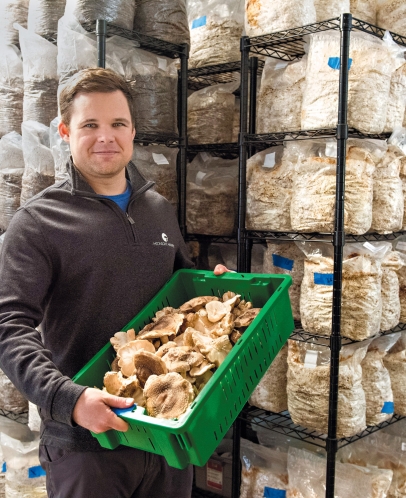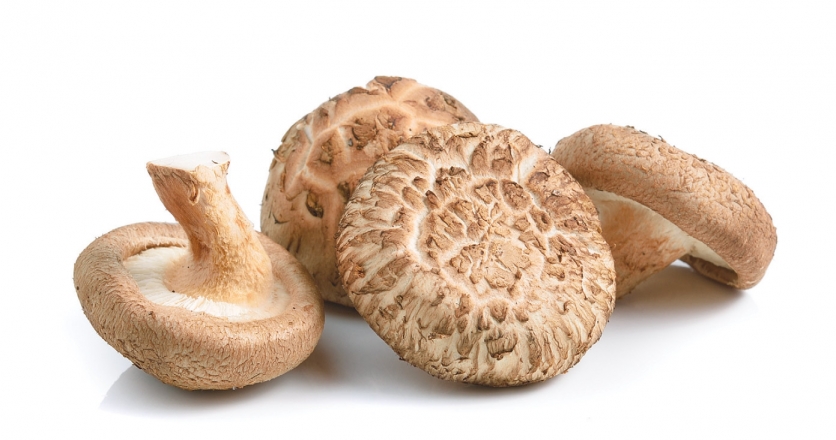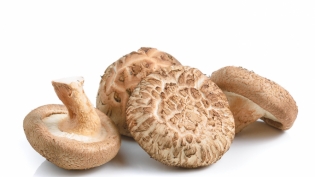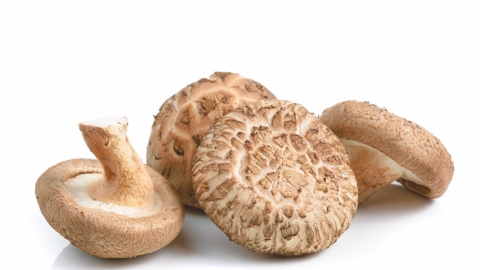Midnight Harvest Mushrooms
When Matt Hall talks about the scientific intricacies of the experiments and other activities that take place in his fungi-growing lab, Midnight Harvest, he always uses the first person plural pronoun “we.” One imagines a team of people in white coats and sterile gloves working at various stations in the room. But there are no other people. Just Matt and his mushrooms. That might seem strange, but actually “we” is the perfect characterization of the symbiotic relationship between him and the subjects of his studies, which is a constant dialogue of questions and answers.
You think you know mushrooms? Well, prepare to be amazed. These enigmatic organisms have superpowers that put Captain Marvel to shame. And Traverse City native Matt Hall, who found his calling in mycology—the branch of biology dealing with fungi—has a few superpowers of his own, although he would never call them that. Over the years he has morphed from being a marine mammal trainer for Disney into an award-winning bartender before putting his major focus on growing gourmet mushrooms. And the surprising thing is that there are parallels to be found in these occupations.
HANGIN’ WITH FLIPPER
Hall grew up in Traverse City and says he had wanted to be a dolphin trainer for as long as he can remember. It’s just that, well, he wasn’t anywhere near an ocean. But when he was a student majoring in science and arts at Northwestern Michigan College in Traverse City, fate stepped in. “Disney came to NMC in the fall of 2003,” he recalls. “I was looking for a summer internship, and I found out they actually had one that involved working with dolphins! I applied, along with hundreds of others—and my ace in the hole might have been the fact that I had been certified in scuba diving since the age of 13.”
Hall was accepted and assigned to Epcot Center’s “The Living Seas” installation at Disney World in Orlando. “We worked with two Atlantic bottle-nosed dolphins—the species that most people would identify as ‘Flipper,’” he says, with a wide smile. “We also had two West Indian manatees, two large sharks and a 400-pound sea turtle. Sometimes I would be underwater for eight or nine hours, just coming up to change tanks or have something to eat. I loved every minute of it!”
Fast-forwarding, Hall returned to Traverse City in 2007 and began bartending (something he’d been doing since the age of 18) at the fine-dining Asian restaurant Red Ginger. He served as bar manager from 2008 to 2011. In 2011, he took a year’s sabbatical to see if he still wanted to get his feet wet—literally. He moved to Grand Rapids and volunteered as a diver for the John Ball Zoo, working with penguins and small sharks. But it was also in Grand Rapids that Hall got into growing his own food and considered becoming a farmer. About the same time, he was introduced to the work of Paul Stamets, a highly respected fungi expert whose TED talks have earned him the title “renaissance mycologist.” Stamets’ presentations inspired Hall to decide that his “farm” would be an indoor, sustainable operation where he could research and grow mushrooms.
Back home again in 2012, he returned to Red Ginger and bartending, but on the side began preparing to launch his new venture. He studied mushrooms intensively, and when a small mycology conference came to Michigan with fungi expert, author and educator Peter McCoy presenting, he signed up.
“There were about 30 people in the room,” says Hall, “and the first question McCoy asked was, ‘Who here wants to grow mushrooms to learn about how they can benefit our lives medicinally and socially, and how they can change the world?’ And everyone but me raised their hand. And then he asked, ‘Who here wants to make money?’ And I raised my hand, because if I’m making money, I can afford to do all of that and more.” He spent the next five years building and learning—and, he admits, making mistakes. “How can you learn if you don’t?” he asks.
It wasn’t until about 2016 that Hall’s mushroom farming operation started to really take off, and he finally gave it a name: Midnight Harvest. “It was an homage to all my bartending years while I was developing the business.” (He still works at Red Ginger part time.) “I’m harvesting at midnight when I get home from working at the bar!” For now, Midnight Harvest is supplying shiitakes to Red Ginger on a regular basis, and occasionally to Towne Plaza and Cooks’ House. There has also been interest from other restaurants and some retailers around the region.
FUNGI PSYCHOLOGY
“It was amazing working with dolphins and other marine mammals,” says Hall. “And even though that didn’t turn out to be my profession, I utilize a lot of the psychology of dolphin training with my mushrooms.” Wait, what? According to Hall, it’s something called “operant conditioning,” or positive reinforcement.
“Just imagine that there is something you can’t talk to,” he says. “You can’t talk to dolphins—they can’t hear the sound of our voice because their frequency level needs a high pitch of vibrations. So in training situations, we use a whistle as a way of saying, ‘Come back and get some food, I like what you did there.’”
OK, but how does that relate to mushrooms? “If you think about it, a mushroom is something else you can’t talk to,” Hall explains. “Essentially, you’re learning how to positively reinforce the mushroom. You take your cues from interacting with it. You run multiple tests and put it in multiple situations, and it will eventually tell you something. For example, if you’re giving it nutrition, what can you learn from that? What is it telling you, if anything? Is it growing faster or slower? Is it producing something that you’ve never seen before? The process is very binary—it’s ones and zeros, like yes’s and no’s. It’s a controlled environment, so you write it all down and study it, and in some ways you can influence the mushrooms to do what you want. The objective is to get them to a point where they’re edible and there’s a predictable yield and they taste amazing.”
THE NEXT BLOCKBUSTER: MUSHROOM VS. MOLD
In the beginning, Hall’s mushroom work was about 50/50 with morels and shiitakes. But he soon realized that if he focused exclusively on the shiitake, he would make progress more quickly. It was also a good business move, since shiitakes are the best-selling mushroom in the world. “However, the shiitake is one of the more difficult mushrooms to grow indoors,” he says, “mainly because you have to be very careful to maintain a sterile environment.”
And here begins a fascinating saga that unfolds like a science fiction/fantasy movie—remember the superhero connection? In this indoor mushroom kingdom (that would be Hall’s lab), the spawn—a substance that has been inoculated with mycelium, the vegetative growth of a fungus—is applied to a moist, nutritious substrate inside a specialized sterile growing bag fitted with a 0.2- micron filter patch, which allows oxygen to come in and carbon dioxide to come out. When the mycelium takes hold and is breathing and eating, it begins to colonize the substrate, growing in and around it, eventually forming its own growing structure in the bag—like a solid block.
But wait, the plot thickens: Mold spores, the powerful archenemy of the mycelium, readily float through the air, so you must have a protector (that would be the flow hood) that filters air coming into the lab and keeps the mold spores—which can be as small as 1 micron—out. If even one spore gets through the flow hood, it will head straight to a bag of mycelium. Once it enters, a scary green mold from the Trichoderma genus begins to emerge, and it’s basically a battle of fungus against fungus—one that the villain mold wins, because it reproduces a thousand times faster. It overtakes the whole microenvironment inside the bag, and the mycelium is doomed.
And here’s another twist: Mold spores are not visible to the human eye. There’s no test or indicator that alerts the leader of the kingdom (that would be Hall) to their presence—until he finds a big bag of contamination. And then there’s nothing to do but fix the flow hood and start over. Luckily, this scenario is rare. When the flow hood is working properly, there is usually a happy ending. After about two months it will be obvious that the bag has lost moisture, which means that the mycelium is breathing, alive and well, and will soon form a mushroom as we know it.
LION’S MANES, MAITAKES AND MORELS, OH MY!
Besides the shiitake, Hall also grows maitake (which grows in a cluster and is sometimes referred to as hen of the woods) and lion’s mane (a large white fungus with long, shaggy-looking spines). Like his shiitakes, Hall’s lion’s mane is operational, but maitakes are still in the testing stage. “We’ve definitely figured out a lot about the maitake,” says Hall. “Clearly, with nutritional levels, we’re fine—we don’t have to change much there. The first round of samples took three months to grow, but my second ones took only a month, and their caps are about a quarter-inch thick, which tells me we’re on a good route.”
As for morels, Hall is still trying to find their best path, even though he already has a handle on how and why they are created. “We’ve been able to get morels to fruit in a Petri dish on a microscopic level,” he says, “and judging from the results I’m seeing from my research and testing, there’s a good chance that we will be able to produce morels on a scalable, sellable level in the not-too-distant future. And in the meantime, we can take a lot of what we learn from one strain of mushroom and apply it to most others. They all have the same process, but you have to make some small changes for each species. I’ve learned to move one mushroom at a time, to perfect it, to get it to operational level, and then circle back around.”
THE CIRCLE OF LIFE
Mushrooms play an integral role in the circle of life—that of renewal—by breaking down dead trees, leaves, insects and all sorts of decomposing material so that the earth can use it again, Hall explains. “The magic we see above ground as ‘the mushroom’ is not even one percent of the total mass of the actual organism that is breaking down material below our feet without us ever realizing it.
“And besides their culinary applications, fungi are being explored by the scientific world on many levels, including how we can use them for the greater good of mankind.” And this is real-world stuff—not just a pipe dream: Oyster mushrooms, for example, which have a digestive nature unparalleled in the mushroom world, have already proven their ability to ingest and digest plastics in a relatively short period of time—a matter of weeks instead of the nearly 400 years that plastics normally take.
“I read one study on oyster mushrooms from the Brazilian rainforest done at Utrecht University [in the Netherlands] where they treated plastic with UV radiation and the mushrooms were actually able to eat the plastic—and were still edible afterward,” he says. “There have also been studies on oil spills, both on land and on water, where oyster mushrooms ingested all of the oil, and no residual biofuels were found in the caps afterward.”
Interestingly, scientists have discovered that in the biome of plants and fungi and humans, we have much more in common with fungi than with plants. We need plants for oxygen—they are basically little “air scrubbers”—but when you look at how we breathe in oxygen and breathe out CO2, how we digest our food and how we reproduce, as well as our common need for the sun and vitamin D, the similarities to mushrooms are uncanny. Except that they have superpowers that we can only dream of.
Hall has a way of getting anyone he talks to almost as excited as he is about fungi. “But when you grow mushrooms for a living,” he says, “people also can’t resist asking, ‘Are you a fun-gi (fun guy)?’ And I tell them, ‘Of course I am!’” So what does this “fun guy” do for fun? “I do mushrooms—that’s my passion. When I’m not bartending, I go right back to my lab.”
In Good Taste and Good Health
Shiitakes are both delicious and nutritious, which is a strong case for including them (as well as other mushrooms) in your diet. They have also been used in traditional Chinese medicine for thousands of years. Cornell University and the nonprofit World’s Healthiest Foods website, as well as other reliable sources, list some of the potential dietary and health benefits that shiitakes offer:
• Low in calories
• High in protein
• Rich source of B vitamins
• Provide dietary fiber and minerals with no fat
• Antiviral, antimicrobial, anti-inflammatory, antioxidant
• Linked to better regulation of blood sugar, insulin levels and blood pressure
Choosing, Storing and Cooking Shiitakes
Cultivated shiitakes that are grown outdoors can produce large flushes in the warm days of spring, so it is fortunate they pair well with other spring foods such as green onions, spinach, peas, green garlic, ramps, asparagus and early salad greens or herbs. They also complement chicken and egg dishes and fish, especially trout. Saute, roast or fry them and use them in omelets or frittatas, pastas, soups, stews, sauces and salads (see recipes). Hall recommends simple preparations, but advises that all types of mushrooms need to be cooked thoroughly before eating. He also emphasizes that shiitake stems are inedible due to their tough, fibrous texture. They can be used to add flavor to stocks, however, since they will be strained out later.
When buying shiitakes, look for those that are firm, plump, clean and dry. No need to clean them if they are from an indoor growing facility like Midnight Harvest. If they are from another source and there is visible dirt, brush it off or wipe with a damp paper towel. They will keep up to a week in the refrigerator when stored whole in a loosely closed paper bag or sliced and placed in an airtight storage container.







